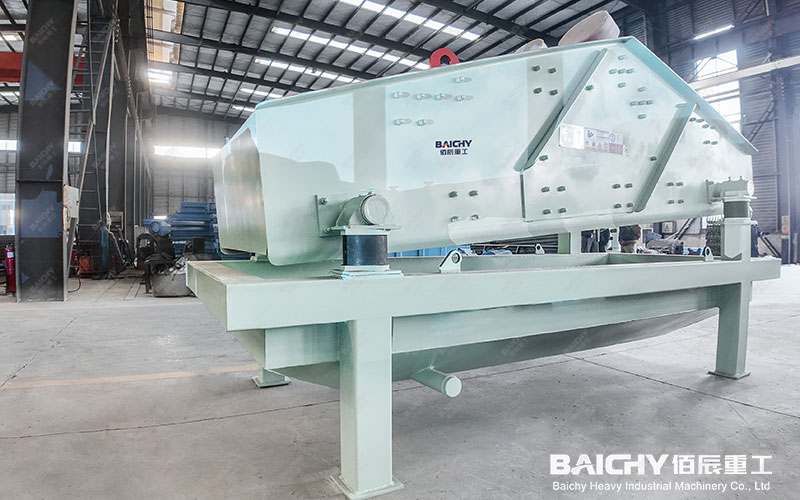
In the increasingly competitive mining industry, cost control and efficiency improvement at every stage of production directly impact a company's final profits. Have you ever been troubled by the following issues: excessive product moisture content affecting selling price? Rising tailings treatment costs? Loss of valuable fines leading to low recovery rates?
If the answer is yes, then your process flow may be missing a crucial, highly efficient "lean" piece of equipment—a mining dewatering screen. It's not just a simple dewatering machine; it's a strategic investment that optimizes processes and directly enhances profitability.
I. The Core Value of a Mining Dewatering Screen
Traditionally, the function of a dewatering screen is simply "dewatering." However, in modern mineral processing, its value goes far beyond that. A high-performance mining dewatering screen is a key piece of equipment integrating dewatering, desliming, demediuming, and fine particle classification. Through high-frequency vibration and screen action, it efficiently separates materials, achieving the following multiple objectives:
1. Improved Product Quality and Selling Price: Dewatering concentrate significantly reduces product moisture content. 1. Drier products mean lower weight transportation costs and higher quality, directly enhancing the product's market value and competitiveness.
2. Reduced tailings treatment costs and risks: Dry tailings disposal produces dry-piled tailings. This significantly reduces tailings dam capacity pressure and safety risks, lowers transportation and storage costs, and is more environmentally friendly and safer.
3. Recovery of valuable fine particles: During dewatering, fine sand and microparticles easily lost in traditional methods are effectively recovered, improving the overall resource recovery rate, turning waste into treasure, and directly increasing revenue.
4. Achieving water resource recycling: The clarified water produced can be directly recycled for use in the production process, which is of great significance in water-scarce areas, effectively saving on new water procurement and treatment costs.
II. Changing the Process Flow
From "Cost Center" to "Profit Center" Transformation: Scientifically embedding mining dewatering screens into your existing processes will produce immediate results in the following key areas:
• After magnetic separation/flotation: As the final dewatering equipment for concentrate, it ensures that the finished product meets optimal standards. • After a spiral classifier or hydrocyclone: As a dewatering and recovery device for fine sand, it solves the problem of excessively fine materials and difficulty in dewatering, achieving a recovery rate of over 90%.
• In the tailings treatment stage: As a core device in the tailings dry stacking system, it works in conjunction with thickeners to achieve clean and resource-based treatment of tailings.
Process Flow Optimization Comparison:
• Traditional Process: High product moisture content → High transportation costs, low selling price; Direct tailings slurry discharge → Limited storage capacity, high environmental risks, high costs; Fine material loss → Loss of profits.
• Optimized Process: Dry product → Increased selling price, customer satisfaction; Dry tailings stacking → Safe and environmentally friendly, significantly reduced costs; Fine material recovery → Creates additional revenue.
This transformation directly turns what was originally a cost-consuming process into a "profit center" that creates new value and saves costs.
III. Why is investing in a dewatering screen a "high-return" choice?
Many decision-makers focus on "How much does a dewatering screen cost?", but a more crucial question is: "How much will I lose each year if I don't invest in a dewatering screen?"
Let's do the math:
1. Increased Revenue:
◦ Increased price per ton due to reduced product moisture content.
◦ Additional sales revenue from recovered fine materials.
2. Cost Savings:
◦ Significantly reduced costs for tailings transportation and storage.
◦ Savings on water and wastewater treatment fees through water recycling.
◦ Reduced potential remediation costs due to reduced safety risks at tailings ponds.
Typically, a high-quality dewatering screen can recoup its entire investment cost within a few months to a year through increased revenue and cost savings, after which it continuously contributes to the company's net profit. This is undoubtedly a highly profitable investment.
IV. How to Choose the Right Mining Dewatering Screen for You?
Improper selection can lead to wasted effort. The key is to "tailor the solution to your needs":
• Characteristics of the material being processed: Particle size distribution, specific gravity, viscosity, throughput.
• Process Objective: Is the primary focus on dewatering or fine material recovery?
• Equipment Quality: Screen wear resistance, vibration motor reliability, structural stability.
• Supplier Services: Can you provide process design solutions, installation guidance, and comprehensive after-sales service?
In an era of low profit margins, profits stem from meticulous control over every detail. Mining dewatering screens are no longer just an "optional" part of the mineral processing flow; they are an essential component for achieving refined, efficient, and profit-maximizing production. They not only change a process flow but also fundamentally alter your cost structure and profit model.
Take action now! Consult our process engineers to tailor a process optimization solution based on mining dewatering screens and begin your journey to improved profitability!










